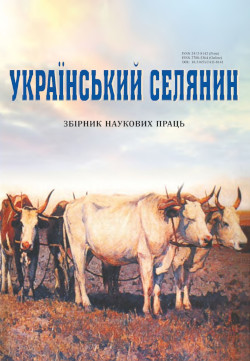Еволюція системи короткотерміново- го сільськогосподарського кредитування в другій половині ХІХ – на початку ХХ століття
##plugins.themes.bootstrap3.article.main##
Анотація
Abstract. The goal is to find out the conditions for the emergence and organizational and legal foundations of the system
of short-term agricultural crediting, to highlight the main stages of the evolution of this system, to characterize the advantages
and disadvantages of the most widespread types of short -term agricultural crediting on the territory of the Dnipro region ,
to analyze the proposals, remarks, arguments and projects of the figures of the Dnipro Ukraine regarding improvement of the
system of short-term lending in the Russian Empire in the second half of the 19th - at the beginning of the 20th century.
Scientific novelty. The primary shifts and patterns in the short-term agricultural credit system from the time
it was established in the Russian Empire until the turn of the 20th century were examined, based on the relevant
sources and the application of contemporary methodological techniques. Key phases in the lending system’s
evolution are examined, along with the interactions between different participants, while accounting for the
sociocultural and economic obstacles of the era. The research findings enhance our comprehension of the evolution of the
rural economy’s financial support and its influence on the growth of the agricultural sector over the studied historical period.
Conclusions. Until the 1880s, the Russian Empire as a whole and the regions of the Dnipro region in particular lacked a
system of microloans to support the growing requirements of agriculture. Simultaneously, a number of facts clearly show that
advance loans, promissory notes, and loans backed by goods were vitally needed by farmers. The owners’ needs could not be
fully met by the mortgage loan because, at best, it was mostly used for land purchases or even only for personal consumption,
with no improvements. Additionally, it played a role in the money shifting from the agricultural to the non-agricultural sectors.
For many farmers, granting access to short-term loans ensured regular operations. After taking a look at the historical
development of the solo promissory note loan, we can see that it was significantly less than the standard promissory note
credit, outperforming it only in the more difficult loan issuance process. Because of this, landowners who haven’t yet restored
their farms in compliance with the new requirements found it difficult to use it conversely, owners-entrepreneurs found it more
advantageous to use alternative kinds of finance.
##plugins.themes.bootstrap3.article.details##
Посилання
Anfimov, A. (1969). Krupnoe pomeshchiche khozyaistvo Yevropeiskoi Rossii. Konets XIX – nachalo XX veka [Large landed estates in European Russia. The end of the 19th – the beginning of the 20th century.]. Moskva : Nauka. [in Russian].
Gindin, I. (1960). Gosudarstvennii bank i ekonomicheskaya politika tsarskogo pravitelstva (1861 – 1892) [State Bank and economic policy of the tsarist government (1861 – 1892)]. Moskva. [in Russian].
Gurev, A. (1904). Ocherk razvitiya kreditnikh uchrezhdenii v Rossii [Essay on the development of credit institutions in Russia]. Sankt-Peterburg : Tip. A. G. Rozena. [in Russian].
Kabat, I. (1888). K voprosu o selskokhozyaistvennom kredite [On the issue of agricultural credit]. Sankt-Peterburg: Tip. Min. Vnutr. Del. [in Russian].
Korelin, A. (1988). Selskokhozyaistvennii kredit v Rossii v kontse XIX – nachale XX v. [Agricultural credit in Russia at the end of the 19th – beginning of the 20th centuries]. Moskva : Nauka. [in Russian].
Korchinskii, S. (1893). K voprosu o selskom krestyanskom kratkosrochnom kredite i yego organizatsii [On the issue of rural peasant short-term credit and its organization]. Kiev. [in Russian].
Sbornik deistvuyushchikh k 1 yanvarya 1912 g. nakazov, pravil i tsirkulyarov Gosudarstvennogo banka po ssudam na snabzhenie selskikh khozyaev oborotnimi sredstvami [Collection of orders, rules and circulars of the State Bank in force by January 1, 1912 on loans for supplying rural owners with working capital]. (1912) Sankt-Peterburg : Tip. V. F. Kirshbauma. [in Russian].
Selikhov, D. (2019). Silskohospodarskyi kredyt na ukrainskykh zemliakh Rosiiskoi imperii u 1861 – 1917 rr.: istoryko-pravove doslidzhennia. [Agricultural credit in the Ukrainian lands of the Russian Empire in 1861-1917: historical and legal research]. Dnipro : Dniprop. derzh. un-t vnutr. sprav. [in Ukrainian].
Tsentralnyi derzhavnyi istorychnyi arkhiv Ukrainy. F. 442. Op. 542. Spr. 100. [in Ukrainian].
Iakymenko, M. (1981). Mihratsii ukrainskoho selianstva (1861 – 1905 pp.) [Migrations of the Ukrainian peasantry (1861 – 1905 pp.)]. Ukrainskyi istorychnyi zhurnal. [Ukrainian historical journal], 9, 61–71. [in Ukrainian].

